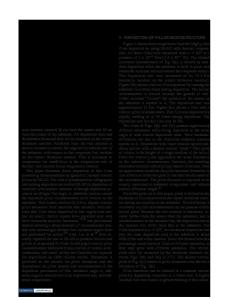Texture and Microstructure Evolution in Silver Thin films with FACET
- PDF / 103,219 Bytes
- 6 Pages / 612 x 792 pts (letter) Page_size
- 48 Downloads / 461 Views
P8.14.1
Texture and Microstructure Evolution in Silver Thin films with FACET Asit Rairkar1, Jie Zhang2 and Jim Adams1 1 SEM Program , Arizona State University, Tempe, AZ 85287-1704 2 Research and Development, Cypress Semiconductor, San Jose, CA, 95134 ABSTRACT Metallic polycrystalline thin films are used in a plethora of applications, including especially metallic interconnects for the microelectronics industry. Despite the numerous approaches at modeling and simulating processing of these films, there have not been any simulation tools, which can accurately predict texture and microstructure evolution in these films. We have developed a novel 2D model called FACET for the simulation of polycrystalline thin film growth at realistic spatial and time scales. The basic idea is to use the results of smaller-scale atomic simulations (density functional theory, molecular dynamics, and lattice Monte Carlo) to provide input and guidance on the evolution of grain structure and texture on a micron scale. The feature scale model is based on describing grains in terms of two-dimensional faceted surfaces and grain boundaries. The model includes the major phenomena involved in film growth, including deposition, nucleation, surface diffusion (on the substrate and on the growing film), inter-facet diffusion, and grain growth and coarsening. In addition, the texture of each grain is treated individually, so that the texture evolution of the system can be simulated. Predictions of the FACET code are compared with previous experimental studies of texture and microstructure in Silver films. INTRODUCTION The need for prediction of thin film profiles and microstructure based on their deposition condition is well understood. As the semiconductor industry moves towards smaller devices and faster speeds, reliability constraints on thin films as interconnects are becoming more and more stringent. Copper has replaced Aluminum as an interconnect material due to its higher thermal conductivity and resistance to electromigration resistance[3]. Silver[4] is also being investigated as a better alternative, though some reliability issues remain. It is well known that electromigration lifetimes of fcc films are dependent on columnar shape[5] and texture and that textured films are 4 times more reliable than or random textured films[6]. Understanding the mechanisms of thin film growth and being able to predict thin film structure in terms of experimental parameters such as temperature, deposition rate, substrate materials, etc, are very useful for optimizing processing parameters so as to increase production yield and to reduce cost. Typically models for thin film growth can be classified into atomic and feature scale models. Atomic scale models include Lattice Monte Carlo, Molecular Dynamics and its derivatives Hyperdynamics and temperature accelerated Dynamics (TAD) Feature scale models like EVOLVE, SUPREM-DSMC and level-set method. A good review of these techniques can be found in [7] and {Adams, 2000 #24}. Each method has its own advantages and
Data Loading...











